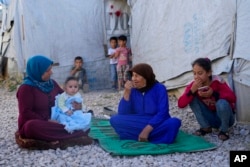More than 13 years after Syria erupted into civil war, the United Nations says the country has become a more dangerous place for civilians, noting that the oppressive government of President Bashir al-Assad that sparked the flames of conflict remains in power and continues to escalate hostilities on multiple fronts.
“The Syria crisis remains one of the most deadly to civilians in the world. Hostilities continue to plague various parts of Syria and have recently seen a sharp spike, particularly in the north,” said Adam Abdelmoula, resident and humanitarian coordinator for Syria, at a news conference in Geneva Friday.
The U.N. Office for the Coordination of Humanitarian Affairs, or OCHA, says 454 civilians, including 88 women and 115 children, were killed in the first 10 months of 2023 because of the conflict.
Those casualties are the latest manifestation of the toll taken by the war on Syria’s population. The U.N. estimates that since the start of the war on March 15, 2011, 300,000 people have been killed, more than 12 million have been displaced — 6.8 million inside Syria and 5.4 million as refugees in five neighboring countries.
Speaking from the capital, Damascus, Abdelmoula said, “Today, a staggering 16.7 million people require some form of humanitarian assistance in Syria,” noting that nearly 13 million people are suffering from acute hunger.
He said the economy is in freefall, causing prices for the most basic commodities to soar. “We hear daily how people are forced to forgo meals, pull their children from school so they can help support the family, or mothers choosing to skip their medications in order to feed their children. This is unconscionable.”
While man-made disasters are largely responsible for the catastrophic situation facing Syria’s civilian population, natural disasters and climate shocks have exacerbated the distress.
OCHA says that the devastating earthquake in February 2023 in northern Syria killed some 6,000 people and injured more than 12,800, “increasing the strain on services, causing displacement, and inflicting widespread damage,” adding that “many families lost their main breadwinner at a time when the economic situation was already dire.”
OCHA says two days of heavy flooding last week affected more than 15,700 people at several displacement camps in Idlib and northern Aleppo. It says that more than 3,300 family tents have been damaged and 500 destroyed in more than 100 flooding incidents in northwest Syria this year.
The U.N. is appealing for $4.07 billion to provide lifesaving humanitarian assistance to 10.8 million people out of the 16.7 million Syrians in need this year.
Abdelmoula warns that funding is almost nonexistent and that the spillover effects of the war in Gaza and other crises are making it difficult to receive support for Syria from the international community.
“We are competing with so many crises. Look at the global picture. You have Gaza, you have Ukraine, you have Sudan, you have Afghanistan — and the list goes on and on,” Abdelmoula said.
“With each emerging crisis, the Syrian one keeps being pushed to the back burner. We are struggling to keep global attention on Syria, and that is proving to be challenging,” he said.
Abdelmoula warns that ignoring Syria’s calls for help will have a dangerous, destabilizing impact in the region and beyond, including “a resurgence of terrorism, which we have seen lately.”
He also warned that turning a blind eye to Syria’s plight will likely trigger a renewed flow of refugees into countries such as Lebanon and Jordan, which already are buckling under the strain of hosting large numbers of Syrian refugees.
“We could see a situation where migration to Europe would increase,” he said, noting that migration numbers in Europe already are surging.
“In 2023, we have seen 181,000 new applications for asylum in Europe. That represents a 38% increase over 2022,” he said.
“If increased resources are not provided because the Syrian people need them, then donor countries should provide them out of sheer national interest,” he said. “Migration is going to increase very significantly, unless we can keep people in their national borders.
“We are still in the first quarter of the year, but with the level of funding that we have and the vulnerability that we see around us, it is not hard to conclude that the migration will only increase.
“It is less costly to provide for people to remain in their countries as opposed to providing for them when they reach any destination of refuge,” he said.












